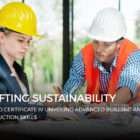Unleash Pro-Level Excellence: AHC30921 Certificate III for Modern Landscape Construction
The AHC30921 Certificate III in Landscape Construction stands as a gateway to pro-level excellence for modern landscape professionals. This comprehensive program delves into sustainable landscaping, outdoor space design, and the intricacies of hardscape and softscape construction. As we embark on this transformative journey, we unveil the secrets of environmental conservation, project management, and the artistry of landscape architecture.
1. Sustainable Landscaping: Nurturing Nature’s Balance
Our journey begins with the essence of sustainable landscaping, a philosophy that goes beyond aesthetics to nurture nature’s delicate balance. Participants explore the historical evolution of sustainable practices, understanding the significance of eco-friendly design in contemporary landscaping. Real-life examples showcase the transformative impact of sustainable landscaping in preserving biodiversity and enhancing outdoor spaces.
2. Outdoor Space Design: Crafting Nature’s Symphony
The program unfolds the artistry of outdoor space design, likened to crafting nature’s symphony. Participants delve into the principles of balance, rhythm, and harmony, understanding how design elements contribute to the overall aesthetic appeal of outdoor spaces. Analogies draw parallels between landscape design and composing a musical masterpiece, where each element plays a unique role in creating a harmonious experience.
3. Environmental Conservation: Guardians of Green
Environmental conservation becomes the mission of landscape professionals, portrayed as guardians of green spaces. The program emphasizes the metaphorical role of professionals as stewards, responsible for preserving natural habitats and promoting biodiversity. Real-life examples highlight the impact of conservation efforts in mitigating environmental challenges and creating sustainable landscapes.
4. Hardscape Construction: Building Foundations
Hardscape construction is explored as the art of building foundations in outdoor spaces. Participants engage in metaphorical construction, understanding how elements like pathways, walls, and structures form the backbone of landscape architecture. Real-life examples showcase the transformative impact of well-crafted hardscape elements in creating functional and aesthetically pleasing outdoor environments.
5. Softscape Elements: Painting with Nature’s Palette
Softscape elements are likened to an artist’s palette, allowing professionals to paint with nature’s colors. The program explores the selection and arrangement of plants, flowers, and foliage, creating living artworks within landscapes. Analogies draw parallels between softscape design and the strokes of a painter’s brush, emphasizing the creativity involved in curating vibrant and harmonious natural compositions.
6. Landscape Architecture: Mastering the Canvas
Landscape architecture emerges as the mastery of a canvas, where professionals become artists shaping outdoor environments. Participants delve into the historical significance of landscape architecture, understanding its evolution and influence on modern design principles. Real-life examples showcase iconic landscape architectural projects, inspiring professionals to become visionaries in their field.
7. Soil Management: Nurturing the Earth’s Canvas
Soil management is portrayed as nurturing the earth’s canvas, ensuring a fertile foundation for vibrant landscapes. Participants explore the metaphor of soil as an artist’s medium, understanding how proper management enhances plant health and contributes to the overall aesthetic appeal. Real-life examples highlight the transformative impact of soil management in creating thriving and sustainable outdoor spaces.
8. Plant Selection: Curating Nature’s Symphony
Plant selection becomes a curator’s task, akin to selecting instruments for a symphony. The program delves into the principles of selecting and arranging plants, considering factors such as color, texture, and seasonal variations. Analogies draw parallels between plant selection and composing a melodic arrangement, emphasizing the role of professionals in creating captivating natural compositions.
9. Irrigation Systems: Watering the Symphony
Irrigation systems are likened to watering a symphony, ensuring that each element of the landscape receives the necessary hydration. Participants explore the metaphor of irrigation as conducting water as a musical conductor guides the flow of music. Real-life examples highlight the efficiency and sustainability of well-designed irrigation systems in maintaining healthy and vibrant landscapes.
10. Project Management in Landscaping: Orchestrating Success
Project management in landscaping is portrayed as orchestrating success, where professionals navigate the complexities of planning, executing, and completing projects. The program emphasizes the metaphorical role of professionals as conductors, ensuring that every aspect of a project contributes harmoniously to the overall success. Real-life examples showcase effective project management in creating iconic landscapes.
11. Green Building Practices: Constructing Sustainable Legacies
Green building practices emerge as the construction of sustainable legacies, where professionals contribute to eco-friendly and energy-efficient designs. Participants explore the metaphor of green building as constructing a legacy that harmonizes with the environment. Real-life examples showcase the impact of green building practices in creating landscapes that stand as testaments to environmental stewardship.
12. Landform Design: Sculpting Nature’s Terrain
Landform design is portrayed as sculpting nature’s terrain, where professionals become artists shaping the topography of outdoor spaces. The program explores the metaphor of landform design as sculpting a landscape’s personality and character. Real-life examples showcase innovative landform designs that transform ordinary spaces into captivating and functional outdoor environments.
13. Garden Aesthetics: Crafting Visual Narratives
Garden aesthetics are likened to crafting visual narratives, where professionals become storytellers through their designs. Participants delve into the metaphor of gardens as canv
In conclusion, the AHC30921 Certificate III in Landscape Construction encapsulates a transformative odyssey into the realm of pro-level excellence for modern landscape professionals. As we traverse the diverse landscapes of sustainable landscaping, outdoor space design, and the intricate artistry of hardscape and softscape construction, we unveil the secrets of environmental conservation, project management, and the mastery of landscape architecture.
Environmental conservation becomes the mission of landscape professionals, positioning them as guardians of green spaces. The metaphorical role of stewards underscores the responsibility to preserve natural habitats and promote biodiversity. Real-life examples illuminate the impact of conservation efforts, reinforcing the crucial role landscape professionals play in mitigating environmental challenges and creating sustainable landscapes for future generations.
Garden aesthetics are likened to crafting visual narratives, where professionals become storytellers through their designs. Participants understand the metaphor of gardens as canvases for visual storytelling, emphasizing the narrative aspect of design. Through this lens, professionals gain insight into creating outdoor spaces that not only appeal aesthetically but also convey meaningful stories, connecting people with nature on a deeper level.
In essence, the AHC30921 Certificate III in Landscape Construction is not just a certification; it is an immersive experience that empowers modern landscape professionals to become architects of nature, stewards of green spaces, and artists shaping living canvases. As participants conclude this transformative journey, they emerge not only with a certificate but with a profound perspective, ready to contribute to the evolution of landscapes that inspire, sustain, and harmonize with the natural world.


